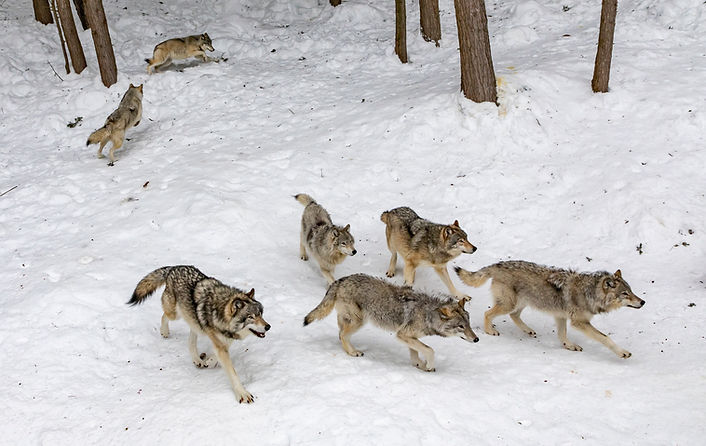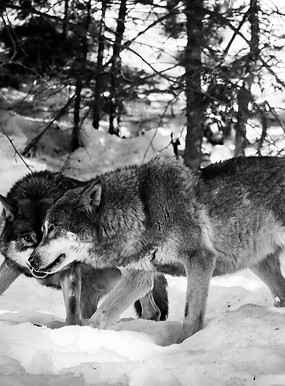top of page
A silver flash striking on the white ground, from the mountaintop to the field, the snow is splashed up here and there. All of a sudden, the pale grass is contaminated as red, and a bunch of fur collides. The flesh is torn to small pieces and bited by sharp fangs. Howling, another elaborate hunting played by a pack of unsatisfied wolves. They have several ways to hunt, and when facing different sizes of prey, wolves vary their methods.
Firstly, wolves have to find a proper target, relying on their keen noses and ears to track. They start with trotting at speed of about 8 kilometers per hour and smell the scent approximately 3 kilometers away from the prey. Since their paws are large and able to flex, wolves are good at seeking food for a long while. After approaching, the wolves observe the prey group and focus on one of them. Generally, it is a weak individual in the group, or the elder one, so the wolves could hunt it successfully without spending too much physical strength. So, Wolves first use their keen noses and ears to find prey, and then lock on a weak one to attack.
When facing big prey, such as bison, elk, and moose, wolves are used to collaborate and isolate an individual prey from their group. Wolves’ further motion depends on how the prey acts. If the prey tries to stand and defend itself, the wolves may either keep fighting or just lose their interest in that prey. Then, wolves probably start to frighten the big prey, forcing it to flee because wolves could be injured severely if directly struggling with big prey, especially the prey with hoofs. Additionally, wolves are acquired delicate feet to run in the snow field, and some of the them play the roles of disturbing the target till it runs out of stamina. So, it is better for the wolves to wait for the best attack timing than to beat the target in the beginning of hunting. After the prey is exhausted, wolves usually bite its nose, having it die soon. Or, wolves can also break prey’s upper hind legs, ensuring that it lose blood and is unable to move. Thus, wolves is skillful to hunt bug prey, with waiting for the prey get tired and attack in a proper timing.
As to medium-sized prey like sheep and deer, wolves are allowed to destroy their throat and cut the artery and the nerve. It will be dead few minutes later soon. When it comes to the smaller prey like hares, geese, and beavers, the wolves can hunt without risk, and the process is like they hunt medium-sized prey. Sometimes, the wolves jump high and flutter to the small prey, and then catch it by the pawl.
The wolves’ hunt starts with finding prey with the sense of smelling and hearing. They could run quite fast with their well-designed feet, and get close to the target even after running for a long distance. Then, the wolves stare at the prey carefully to choose the one which is easy to hunt. If it is a big-sized prey, it takes time and patience, but if it is a smaller one, they could get it soon. People always give these carnivores impressions of being cruel and ambitious to devour. Additionally, apart from that, wolves are also clever hunters, being intelligent enough to balance the risk and adapting the most feasible way to feed themselves calmly.
Sources
Researchers uncover hidden hunting tactics of wolves in Minnesota's Northwoods:
https://www.sciencedaily.com/releases/2021/02/210209151819.htm
WHAT DO WOLVES EAT? :
https://wolfpark.org/animals/wolves/#eat
Facts About Baby Wolves:
https://sciencing.com/baby-wolves-5032180.html
Hunting behavior of gray wolves:
https://en.wikipedia.org/wiki/Hunting_behavior_of_gray_wolves
Living with Wolves: How Wolves Hunt
bottom of page

